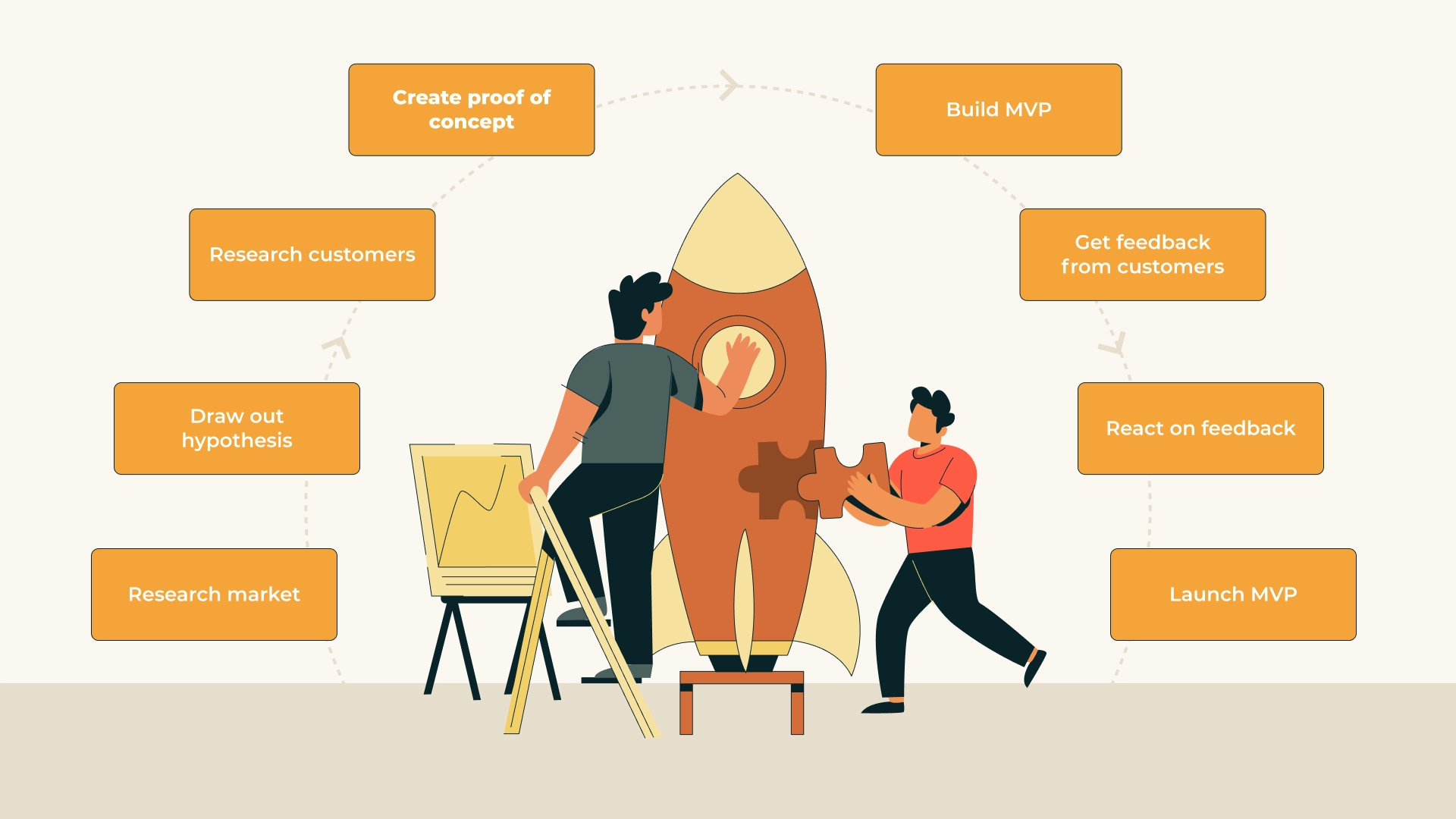

Planning Startup Strategy: Customers First, VCs Later
Most of the startups survive their first year, but start to agonize and die with the passage of time. The main reasons for that are: a product that is not needed and money that are not endless.
We help startups to engineer a good product that the targeted market needs and deliver it to its customers in a not dull way. In this article, we’ll talk about how founders can protect themselves from a) wasting valuable resources on things that are not needed, b) wasting the same resources on the people who don’t want it. More specifically, how to succeed. (The headline is a spoiler.)
Sad truth about customer discovery
“I had,” he said, “come to an entirely erroneous conclusion which shows, my dear Watson, how dangerous it always is to reason from insufficient data.
Arthur Conan Doyle, The Adventure of the Speckled Band
A lot of articles about startup development starts with a notion that idea itself, without evidence of its viability, is useless and no one will give you money for it. Most writings on “how to pitch VCs,” are about how cool and confident a founder must be and how well he or she must know their customers’ needs.
So the logical conclusion is the next equation: study your market and your customer = get money from VCs.
Or: get to know your customers, act on that knowledge, and you will get your rounds.
Or, let’s move to numbers. Customer experience is the most exciting opportunity for 2019 among digital marketers. Businesses who invest in customer research regularly grow faster.
Temkin Group research shows: If you are a business that earns $1 billion annually, investing in customer experience will add to your revenue near $700 million. If you are a software-as-a-service company, that number increases to $1 billion.
86% of companies compete in that framework: the framework of best/worst customer experience.
But here’s what curious: 80% of companies think they do “super experiences.” And only 8% of customers confirm that. Thus, a phenomenon called “delivery gap”: we think we’re great, but we’re not — or not enough.
And if we’re not — just take a look at this Hubspot chart — it's a huge disadvantage, as people tend to complain about poor service to other people. A fact.

So we know customer experience can make us rich — we know its absence can kill our startup. Why don’t we do anything? Because we think we know what customers want.
We test a product between our five friends and call it usability testing. We ask our former colleagues if they like our idea, they agree, and we think it viable. “We don’t need to know everything and we just assume we do”, writes Steven Sloman, cognitive scientist and co-author of The Knowledge Illusion.
(If you think that’s not about your startup, that’s because the writer generalizes and assumes — just as startups tend to).
To prevent yourself from failing — whether it's raising funds or product launch — stop assuming. At least, where emotions and reasonings of other people come into the picture.
Start talking to customers from the stage of conception
We’ve already established that customer experience drives revenue like crazy — and we know that most businesses kinda lie to themselves about their customer experience. Remain vigilant.

It's always time to think about your customers.
It’s always time to engage them in the creation of your product.
It’s always time to listen to them.
1. Discover “whys”
People buy better versions of themselves, not your product. They buy a resolved issue, a challenge that is dealt with, more comfortable experience; something new and exciting, something that conveys emotions for them.
Your product will be successful if you’ll know the clear answer to “why” that stands behind the purchase. Why would these people buy your product?
You can discover “whys” through data: from social media, from surveys, from personal interviews, etc. These sources will give you insights on why people may want your product, where they want to find it, what language and which channels should you use to reach them. You also can discover
- how can you narrow down your product feature or provide more specific, targeted specialized services in the choosen industry;
- what particular challenge on the targeted market you can address right now — basically, what's begging for attention and can be solved through your product,
- if your potential customers occupy a particular position or role within their organization and if you can address role-specific issues, etc.
In other words, there are different “whys”, and that rule works for B2B startups just as good as for B2C: businesses are people. Your complex software solution which uses disruptive technologies should address humanity and be honest: 80% of B2B make decisions about buying that complex software through referrals. If nobody speaks of remarkable things, how can they be called remarkable?
2. Make everyone a customer advocate
We’ve noticed that customer experience is more or less discussed subject across the marketing department. Marketers want to reach a brand’s audience in a personalized way — to do that, they need to understand customer behaviours, thus, customer service and experience.
However, customer journey isn’t owned by the marketing department exclusively.
Actually, if you think about it, every interaction inside your company might have an impact on a customer: an angry employee snaps in the middle of the call — a flash-forward — a negative referral.
So it’s better to make everybody think about customer experience: don’t make marketers or salespeople or frontline employees outsiders. Make thinking about your customer everyone’s job.
These customer insights you got after gathering data through surveys and interviews? Don’t hide them for your next marketing campaign, share them with the whole team.
This new report on customer behaviour in your industry? Share it as well.
And if you think you can let your engineering team wander around without the knowledge of who your customers are and why on Earth that function should look exactly like that — don’t do that.
A bit about misdirected incentives that are typical for almost all engineering departments: while everybody else think about how something helps potential customers or how something sells, developers think if that feature is going to be released in time or it’s bugged and a release requires a reschedule.
David Cancel, CEO at Drift has to say something about that: “The customer doesn’t care that you shipped the product on time or care that the features you decided on at the beginning of your process were there at the end. All the customer cares about is a very selfish thing, which is “What the hell is in it for me? Why should I care? Why should I spend time even thinking about this?”
Product team should think in these patterns too. UX design is actually not a designers-only job: everyone is involved in the creation of good user experience.
It’s easier to think about establishing that “obsessive with customer” mindset from the start, then later, when your company is starting to fail (…to sell, to convert, to scale, etc.) You’ll have the ability to hire people who can relate to the customer-centric concept.
By the way, such “we help people” mindset increases employees’ performance. People like opportunities to do something meaningful, to make a difference, an impact. Even people who spend money on others are happier.
3. Think less about your competitors
These numbers we’ve talked about at the beginning — customer-research related things you’ve probably already forgotten about (or not; assumption) — are not there to seed Doubt, Uncertainty, and Fear. At least, not for that only.
It’s also for you to understand: these three new businesses that launch every second? They have no idea what they’re doing.

You just have to make sure you do.
Note: we’re not telling you to skip competitor research in your marketing research. (Which you, without a doubt, at least consider considering after that article.)
We’re telling you to stop looking over your shoulder, checking how they are doing. Your focus should be with your customers, not your competitors.
What about (raising money and finding time?
We put that thing to the end on purpose.
You’ve read that all and probably thought: ok, that’s sounds great, but I only have an idea, half of a co-founder and my sister who helps me with sales when she’s not working on freelance. So, what about time and money?
Startup founders spend an incredible amount of time pitching VCs. For a hundred of “no”s, they get one (1) “yes”, and it’s accepted and common situation — but it’s exhausting, it’s not fun, it’s tiresome. Mostly, you get negatives — but, as the process is automatic, you may as well send it to the wrong person and get a “yes.” And the wrong investor is just as bad as the wrong co-founder.
Pitching is also all about stress and doubts: am I worthy of funding? Will they help me? Why they aren’t answering, am I not good enough?
Customer discovery will answer these questions and open for you a path for improvement if needed.
Self-doubt numbs a person. Answers provide clarity. Clarity reduces stress.
It is a time you might as well spend on discovering the further path of your startup and product and increase your chances on success.
Customer research gives you facts to understand your audience. It helps you conduct
- POC (proof of concept), a research-based, tested confirmation that your product is needed for the target market, and
- MVP (minimum viable product), an early marketable version of the product that includes main features that can be useful for customers.

And here’s what interesting about these pre-Real-Product things: they can help you understand that your market isn’t as big as you thought (CEOs tend to overestimate the size of targeted markets) and you don’t need to pitch investors at all: They are very unlikely to put their money into a product that has few chances to become large quickly.
Or, through an MVP, you can get a clear picture of what’s a need to be done and realise that at the beginning of your entrepreneurship you don’t need a VC. A lot of great companies didn’t start with VC. Airbnb, Grammarly, Uber. They didn’t get any money. They had a concept and they knew where their market is and what people there want: they grew organically and decided the speed, style, and ways of sharing the profit by themselves.
Surely, investors give founders a lot of confidence, reduce the level of uncertainty around their money. But, as we said, funding is a relationship; investments require throughout approach, you being mindful, not desperate to get something more or less stable in the crazy pace of startupers’ life. You also need to see funding not as a choice of getting money or not getting money but as multiple choices of “needing to grow as quickly as possible” vs “taking my time to acclimatize”; “being in control of my choices and decisions” vs “thinking about what VCs think at the background all the time,” etc.
Anyway, even if you want that funding, it’ll be better, if you put customers first. Even in the context of meetings with VCs, customer research will be helpful. With it, you will convey the knowledge of the target market, its needs, plus how and why these needs can be fulfilled with your product’s benefits quickly and expertly. That’ll make you look cool (as you’ve done this research) and reliable (as you know what you’re doing). Cool founders who know where they’re going are VCs’ soft spot. We’re telling you.
Last thought: We think everybody agrees that startup is a perfect method to really help people. Spend at least a half time (at least) you spend on pitching VCs on getting to know these people, see what they like and don’t like about the current market — and see what happens.
Most probably, you won’t fail.
Tell us about your project
Fill out the form or contact us

Tell us about your project
Thank you
Your submission is received and we will contact you soon
Follow us
